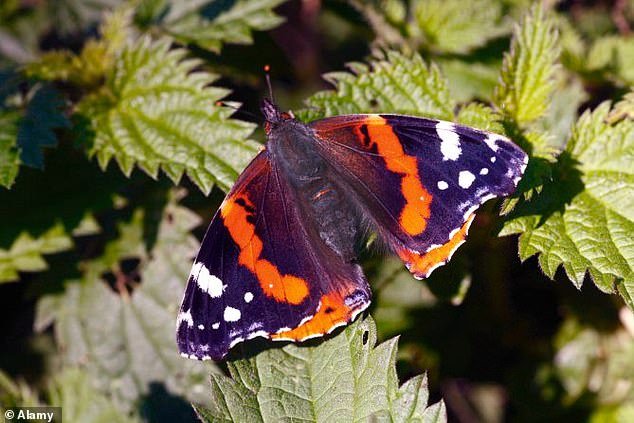Go on, have a flutter! Take a few tips from the new book by biologist Dave Goulson and it’s a safe bet that beautiful butterflies will start gathering in your garden
- Dave Goulson said if you have the right flowers you can still see some butterflies
- Biologist said numbers of garden butterflies are far lower than they once were
- Plant a buddleia and all of these species are likely to turn up occasionally
As a child, I recall the buddleia in our garden attracting dozens of peacocks, small tortoiseshells, red admirals and white butterflies. Sadly, numbers of garden butterflies are far lower than they once were, but if you have the right flowers you can still expect to see some beauties.
Plant a buddleia and all of these species are likely to turn up occasionally, plus, perhaps, commas and painted ladies. Marjoram is another magnet for butterflies: if you live anywhere near large, open spaces or have a big garden then marjoram may attract gatekeepers and meadow browns, common blues and even marbled whites and ringlets if you’re very lucky.
Ragwort is also great, popular with skipper butterflies and small coppers, while thistles and knapweed attract many different butterflies.
Perhaps the most valuable thing a gardener can do is provide suitable flowers in autumn and early spring for those species that spend the winter as hibernating adults.
Greenish-yellow ivy flowers and the ice plant, with its plate-sized arrays of tiny pink flowers, are important autumn resources that are particularly attractive to red admirals and small tortoiseshells stocking up for their winter sleep. In early spring, dandelions, pussy willow and bluebells are great to welcome them out of hibernation with a sugary drink.
Sadly, numbers of garden butterflies are far lower than they once were, but if you have the right flowers you can still expect to see some beauties. Pictured, the Red Admiral Butterfly
You may be tempted to splash out on one of the many ‘butterfly hotels’ or ‘butterfly boxes’ available online or in garden centres, which are intended to provide hibernation places for butterflies.
Some are very attractive to the human eye, but in my experience butterflies show not the slightest interest in them; they do not need a hotel. What is more, although they enjoy flowers, they do not, unlike bees, need to gather large quantities of nectar for their offspring either, and have no interest in pollen.
The key resource they often lack is food plants for their caterpillars. Many of our prettiest common garden butterflies, such as the peacock and small tortoiseshell, lay their eggs on nettles. If you have a good-sized nettle patch, chop some of it back hard in early June as the butterflies like to lay on fresh regrowth.
Perhaps more appealing is to provide clovers and bird’s foot trefoil, which with luck will attract common blue butterflies, the males with flashing sky-blue wings, the females chocolate-brown with orange spots.
Your cabbages are likely to attract both large and small white butterflies – though you may wish they wouldn’t as the larvae feed on them – while cuckoo flowers might draw in orange tips, one of my favourite spring butterflies.
A sunny meadow area may encourage meadow browns, gatekeepers, ringlets and skippers to breed, for their caterpillars feed on grasses; if you can leave a small patch of long grass uncut from one summer to the next you’ll give these butterflies the best chance to develop.
Grow a buckthorn bush and there is a reasonable chance you’ll attract brimstone butterflies, as the larvae feed on the leaves. Which butterflies you attract to your garden depends to some extent on how close you are to an established population of them, but with only a little effort you should be able to attract at least half a dozen of the 70 butterfly species in the UK to breed, even in an inner-city garden.
Gardening For Bumblebees by Dave Goulson is published by Square Peg, £16.99. © Dave Goulson 2021. To order a copy for £14.95 go to mailshop.co.uk/books or call 020 3308 9193. Free UK delivery on orders over £20. Offer price valid until 17/04/21.







